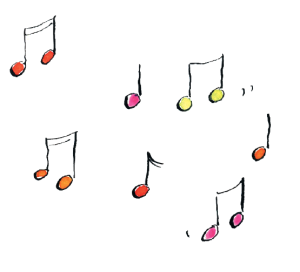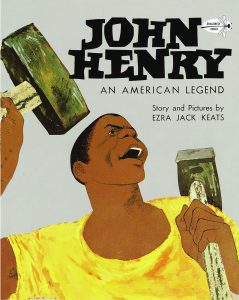Lesson 1: Exploring “John Henry”
Summary: Students learn and sing “John Henry” while understanding how music can be used to tell a story.
Materials: rhythm sticks, Musical Explorers CD or online audio
Standards: GA: ESGMK-2.PR.1, ESGMK-2.RE.1, ESGMK-2.RE.2, ESGMK-2.RE.3, ESGMK-2.CN.1, ESGMK-2.CN.2
SC: GM.PR.NL-AH.3, GM.RE.NL-AH.6, GM.RE.NL-AH.7, GM.CN.NL-AH.8, GM.CN.NL-AH.9
Vocabulary: ballad, folk tale, lyrics, oral tradition, steady beat
Sing “John Henry”
- Listen to Kaia sing the song “John Henry,” Track 3.
- “John Henry” is a type of song called a ballad. A ballad is a song that tells a story.
- Ask students to pay attention to the words of the song. Do they notice Kaia repeating anything?
- Kaia repeats the last phrase of every verse. Listen to Kaia and sing with her when she repeats a phrase.

Oral Tradition and Folk Music
Folk musicians often learn songs from other people in their family or community.
This is called an oral tradition.  The songs are passed down from generation to generation and are learned “by ear.” Often, these songs are so old that we don’t know who originally wrote them. Ask students if they have learned any songs from someone in their family or community. Discuss as a class to connect their experiences to the meaning of oral tradition. What makes it folk music?
The songs are passed down from generation to generation and are learned “by ear.” Often, these songs are so old that we don’t know who originally wrote them. Ask students if they have learned any songs from someone in their family or community. Discuss as a class to connect their experiences to the meaning of oral tradition. What makes it folk music?
“John Henry” is based on a folk tale. A folk tale is a story that is passed down through oral tradition, just like folk music. John Henry was an African-American folk hero who was famous for hammering steel to construct a railroad tunnel. He was placed in a contest against a steam-powered hammer and he won!
John Henry
When John Henry was a little baby, he was
sitting on his papa’s knee.
He picked up a hammer and a little piece of
steel;
Saying, “Hammer’s gonna be the death of me, Lord, Lord.
Response: Hammer’s gonna be the death of me
Hammer’s gonna be the death of me.”
The captain said to John Henry
“I’m gonna bring that steam drill around.
Gonna bring that steam drill out on the job.
Gonna whip that steel on down, down, down.
Response: Whip that steel on down.
Whip that steel on down.”
John Henry told his captain,
“A man ain’t nothin’ but a man,
But before I let your steam drill beat me down,
I’d die with a hammer in my hand, hand, hand.
Response: I’d die with a hammer in my hand
I would die with a hammer in my hand.”
Now the man that invented the steam drill
He thought he was mighty fine,
But John Henry made fifteen feet;
The steam drill only made nine.
Response: That steam drill only made nine.
John Henry hammered in the mountain
And his hammer was striking fire.
He worked so hard, he broke his poor heart.
And he laid down the hammer and he died.
Response: He laid down his hammer and he died.
John Henry had a little woman.
Her name was Polly Ann.
When John Henry got sick and went to his bed.
Polly Ann drove steel like a man.
Response: Polly Ann drove steel like a man.
Well, every Monday morning
When the bluebirds start to sing.
You can hear John Henry for a mile or more.
You can hear John Henry’s hammer ring.
Response: You can hear John Henry’s hammer ring.
You can hear John Henry’s hammer ring.
Explore the Lyrics in “John Henry”
- Lyrics are the words to a song.
- How do the lyrics help to tell John Henry’s story?
- Using the graphic organizer on SG10, use words and pictures to summarize the folk tale of John Henry.
Explore Steady Beat in “John Henry”
- Listen to John Henry again, Track 3.
Ask students to clap their hands or tap their legs as they listen to the song. Explain to students that the steady pulse they feel in the music is the steady beat. The steady beat is like a heartbeat. - Ask students if they can find the steady beat in “John Henry.”
- Using rhythm sticks or pencils, tap the steady beat. You can further explore steady beat by discussing how a steel driver like John Henry would have kept a steady beat while hammering steel. Students can even pretend that the sound of the pencils/rhythm sticks are hammers.
Literacy Extension: Read about John Henry
John Henry: An American Legend by Ezra Jack Keats tells the story of John Henry and the steam drill, as well as other tales of the folk hero.
Creative Extension: Oral Tradition in Musical Games
Many traditional children’s songs are folk songs, including “Froggy Went A-Courtin’,” “She’ll be Comin’ Round the Mountain,” “The Bear Went Over the Mountain,” “I’ve Been Working on the Railroad,” and “Oh Susanna.” Like Kaia’s songs in this unit, many of the songs come from West Virginia and have similar themes, including mountains, railroads, and working.
Many children’s folk songs are also games, especially handclapping games or double-dutch (jump rope) songs. The way we learn those games and songs is an example of oral tradition.
- Do you know any handclapping songs or games? (examples: Miss Mary Mack, Down Down Baby, Down by the Banks, or even Pat-a-Cake)
- How did you learn this song?
- How did you learn the clapping?
Ask a pair of students to be the leaders in teaching the rest of the class a handclapping game. Or, pick a song that everyone knows and create an original handclapping game with your class!
Musical Word Wall
Add ballad, folk tale, lyrics, oral tradition, and steady beat to the Musical Word Wall.
PDF Downloads
SG10 ↓ Download File
Musical Explorers Audio Tracks
